1995 ACURA TL lock
[x] Cancel search: lockPage 1278 of 1771

10. Instal l th e specia l too l o n th e sprin g cover , an d tur n
the shaf t unti l th e locknu t contact s th e plate .
SHAF T
LOCKNUT S
BRAKE SPRIN GCOMPRESSO R07HAE-SG0010 0 SPRIN
G
COVER
CIRCLI PGROOV E
11. Chec k tha t th e flare d en d o f th e sprin g cove r i s belo w
th e circli p groove .
12 . Instal l th e circli p i n th e groove , the n remov e th e
specia l tool .
NOTE : Chec k tha t th e circli p is seated in th e groov e
properly .
13. Coa t a ne w pisto n sea l wit h recommende d silicon e
grease in th e calipe r sea l set , an d instal l i t i n th e cali -
per. PISTO N SEA LReplace .
RUBBERGREAS E
14. Appl y recommende d rubbe r greas e i n th e calipe r
sea l se t t o th e sealin g lip s an d insid e o f a ne w pis -
to n boot , an d instal l i t i n th e caliper .
15 . Coa t th e outsid e o f th e pisto n wit h brak e fluid , an d
instal l i t o n th e adjustin g bol t whil e rotatin g i t clock -
wis e wit h th e tool .
CAUTION : Avoi d damagin g th e pisto n an d pisto n
boot.
PISTO N
LOCKNU T WRENC H
(Commerciall y
available)
16. Instal l th e pa d sprin g o n th e calipe r
PAD SPRIN G
PLATE
SILICON EGREASE
PISTON BOO TReplace .
CIRCLIP
SPRING GUID E
SNA
P RIN G
PLIER S07914-SA5000 0
ProCarManuals.com
Page 1283 of 1771
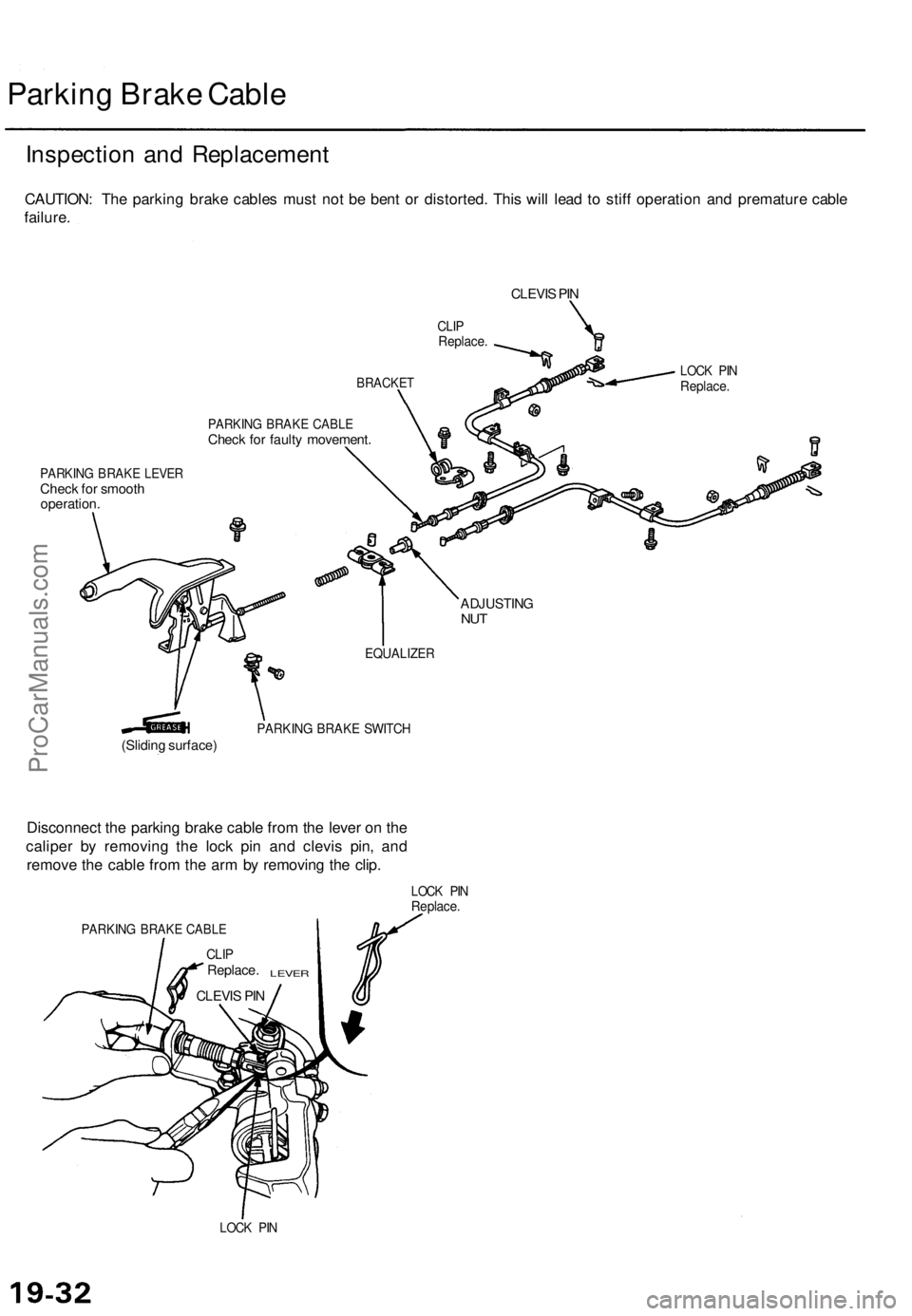
Parking Brake Cable
Inspection and Replacement
CAUTION: The parking brake cables must not be bent or distorted. This will lead to stiff operation and premature cable
failure.
CLEVIS PIN
CLIP
Replace.
BRACKET
PARKING BRAKE CABLE
Check for faulty movement.
PARKING BRAKE LEVER
Check for smooth
operation.
PARKING BRAKE SWITCH
(Sliding surface)
Disconnect the parking brake cable from the lever on the
caliper by removing the lock pin and clevis pin, and
remove the cable from the arm by removing the clip.
PARKING BRAKE CABLE
CLIP
Replace.
LEVER
CLEVIS PIN
LOCK PIN
Replace.
LOCK PIN
LOCK PIN
Replace.
ADJUSTING
NUT
EQUALIZERProCarManuals.com
Page 1286 of 1771
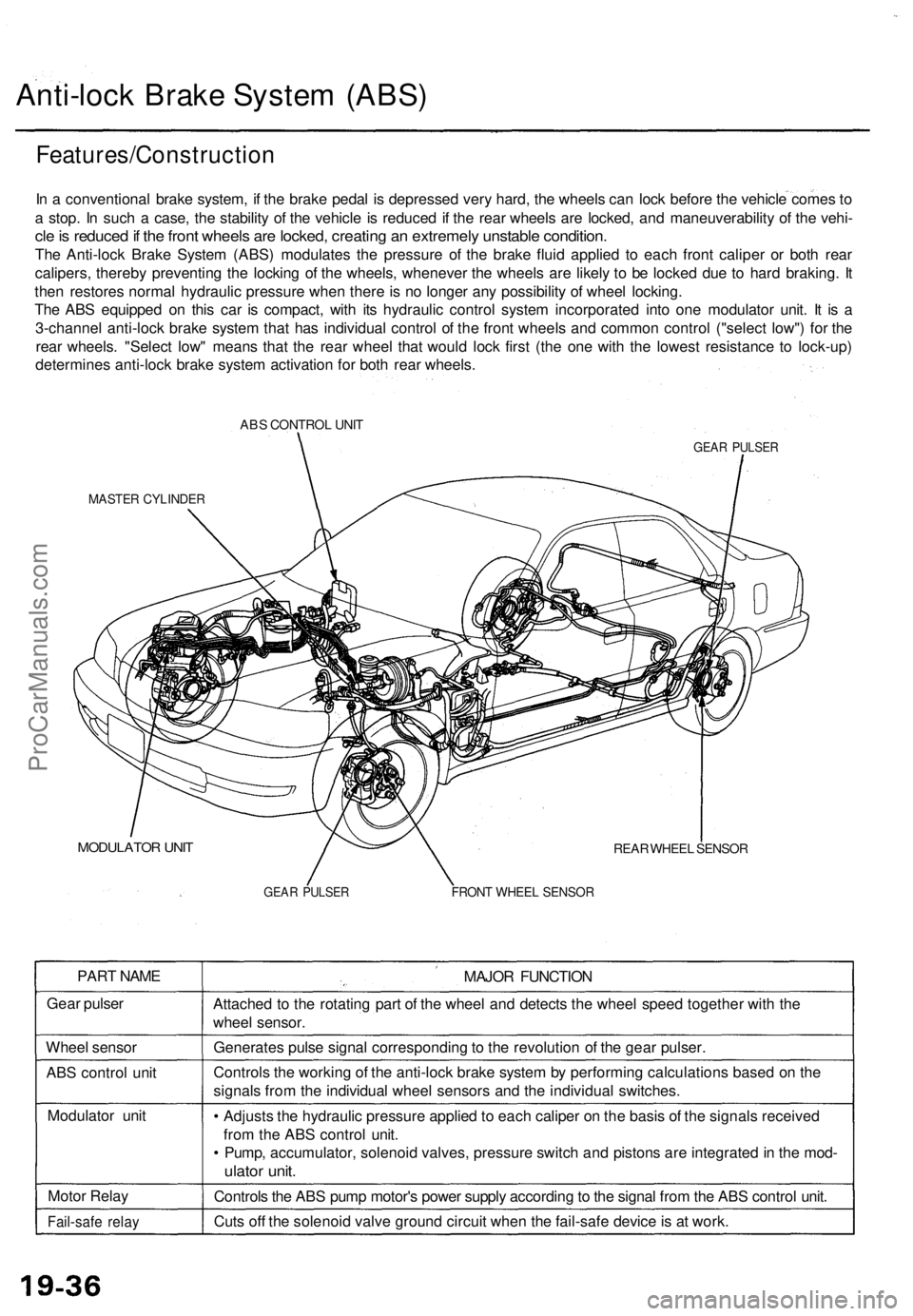
Anti-lock Brake System (ABS)
Features/Construction
In a conventional brake system, if the brake pedal is depressed very hard, the wheels can lock before the vehicle comes to
a stop. In such a case, the stability of the vehicle is reduced if the rear wheels are locked, and maneuverability of the vehi-
cle is reduced if the front wheels are locked, creating an extremely unstable condition.
The Anti-lock Brake System (ABS) modulates the pressure of the brake fluid applied to each front caliper or both rear
calipers, thereby preventing the locking of the wheels, whenever the wheels are likely to be locked due to hard braking. It
then restores normal hydraulic pressure when there is no longer any possibility of wheel locking.
The ABS equipped on this car is compact, with its hydraulic control system incorporated into one modulator unit. It is a
3-channel anti-lock brake system that has individual control of the front wheels and common control ("select low") for the
rear wheels. "Select low" means that the rear wheel that would lock first (the one with the lowest resistance to lock-up)
determines anti-lock brake system activation for both rear wheels.
ABS CONTROL UNIT
GEAR PULSER
MASTER CYLINDER
MODULATOR UNIT
REAR WHEEL SENSOR
GEAR PULSER
FRONT WHEEL SENSOR
PART NAME
Gear pulser
Wheel sensor
ABS control unit
Modulator unit
Motor Relay
Fail-safe relay
MAJOR FUNCTION
Attached to the rotating part of the wheel and detects the wheel speed together with the
wheel sensor.
Generates pulse signal corresponding to the revolution of the gear pulser.
Controls the working of the anti-lock brake system by performing calculations based on the
signals from the individual wheel sensors and the individual switches.
• Adjusts the hydraulic pressure applied to each caliper on the basis of the signals received
from the ABS control unit.
• Pump, accumulator, solenoid valves, pressure switch and pistons are integrated in the mod-
ulator unit.
Controls the ABS pump motor's power supply according to the signal from the ABS control unit.
Cuts off the solenoid valve ground circuit when the fail-safe device is at work.ProCarManuals.com
Page 1288 of 1771
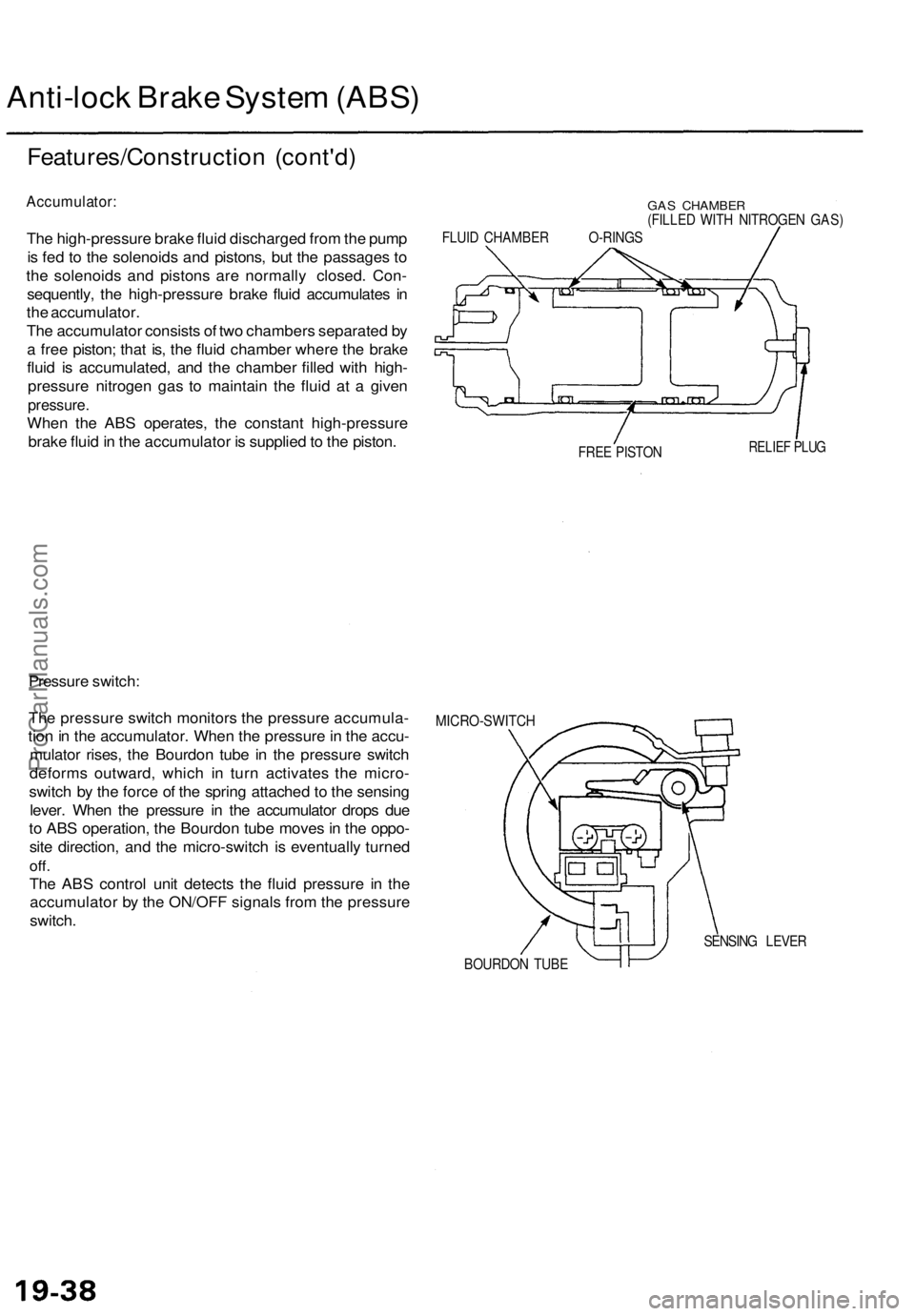
Anti-lock Brake System (ABS)
Features/Construction (cont'd)
Accumulator:
The high-pressure brake fluid discharged from the pump
is fed to the solenoids and pistons, but the passages to
the solenoids and pistons are normally closed. Con-
sequently, the high-pressure brake fluid accumulates in
the accumulator.
The accumulator consists of two chambers separated by
a free piston; that is, the fluid chamber where the brake
fluid is accumulated, and the chamber filled with high-
pressure nitrogen gas to maintain the fluid at a given
pressure.
When the ABS operates, the constant high-pressure
brake fluid in the accumulator is supplied to the piston.
GAS CHAMBER
(FILLED WITH NITROGEN GAS)
FLUID CHAMBER O-RINGS
FREE PISTON
RELIEF PLUG
Pressure switch:
The pressure switch monitors the pressure accumula-
tion in the accumulator. When the pressure in the accu-
mulator rises, the Bourdon tube in the pressure switch
deforms outward, which in turn activates the micro-
switch by the force of the spring attached to the sensing
lever. When the pressure in the accumulator drops due
to ABS operation, the Bourdon tube moves in the oppo-
site direction, and the micro-switch is eventually turned
off.
The ABS control unit detects the fluid pressure in the
accumulator by the ON/OFF signals from the pressure
switch.
MICRO-SWITCH
SENSING LEVER
BOURDON TUBEProCarManuals.com
Page 1289 of 1771
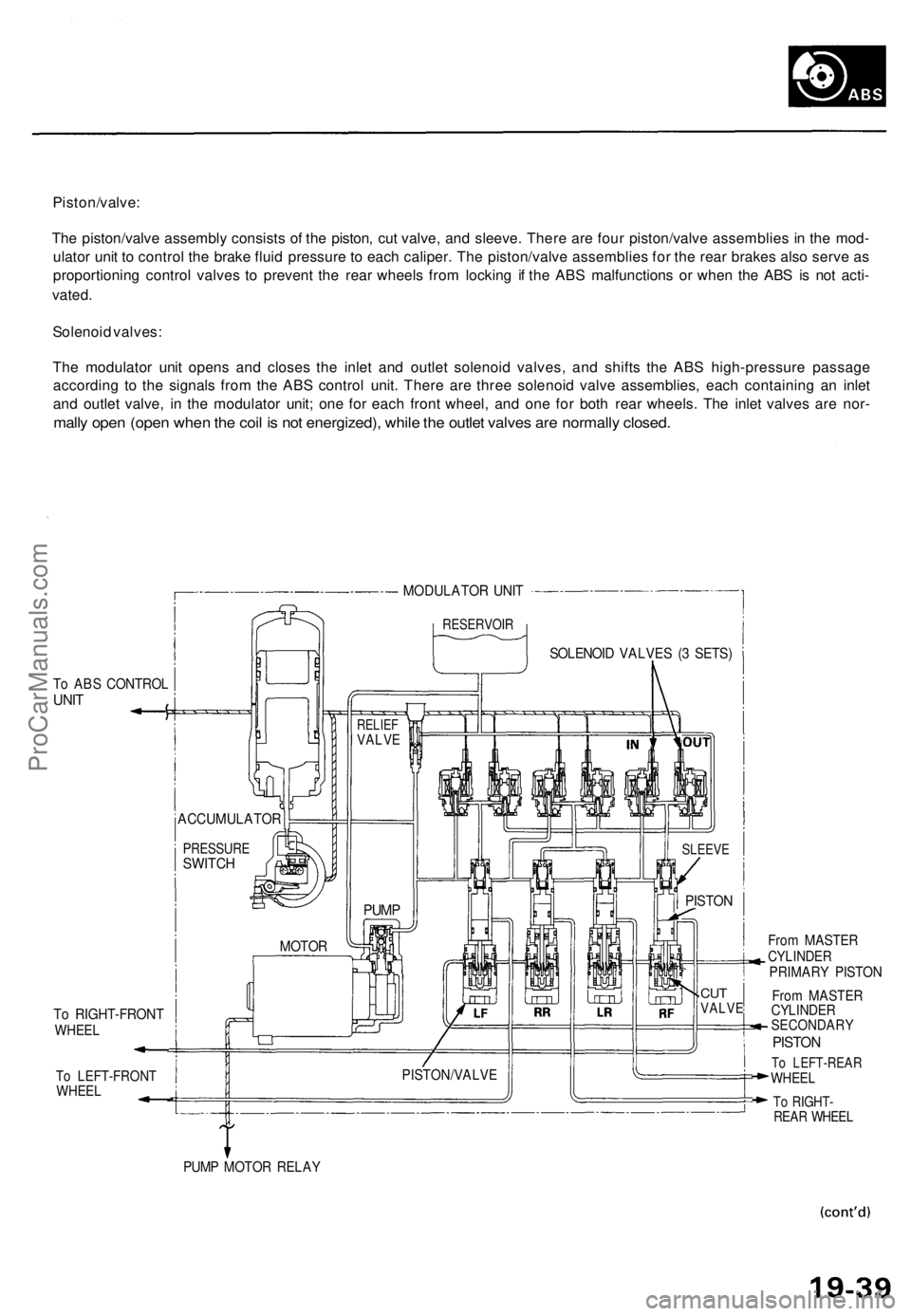
Piston/valve:
The piston/valve assembly consists of the piston, cut valve, and sleeve. There are four piston/valve assemblies in the mod-
ulator unit to control the brake fluid pressure to each caliper. The piston/valve assemblies for the rear brakes also serve as
proportioning control valves to prevent the rear wheels from locking if the ABS malfunctions or when the ABS is not acti-
vated.
Solenoid valves:
The modulator unit opens and closes the inlet and outlet solenoid valves, and shifts the ABS high-pressure passage
according to the signals from the ABS control unit. There are three solenoid valve assemblies, each containing an inlet
and outlet valve, in the modulator unit; one for each front wheel, and one for both rear wheels. The inlet valves are nor-
mally open (open when the coil is not energized), while the outlet valves are normally closed.
MODULATOR UNIT
RESERVOIR
To ABS CONTROL
UNIT
To RIGHT-FRONT
WHEEL
To LEFT-FRONT
WHEEL
PUMP MOTOR RELAY
From MASTER
CYLINDER
PRIMARY PISTON
From MASTER
CYLINDER
SECONDARY
PISTON
To LEFT-REAR
WHEEL
To RIGHT-
REAR WHEEL
MOTOR
PUMP
PISTON/VALVE
CUT
VALVE
PISTON
SLEEVE
SOLENOID VALVES (3 SETS)
RELIEF
VALVE
ACCUMULATOR
PRESSURE
SWITCHProCarManuals.com
Page 1290 of 1771
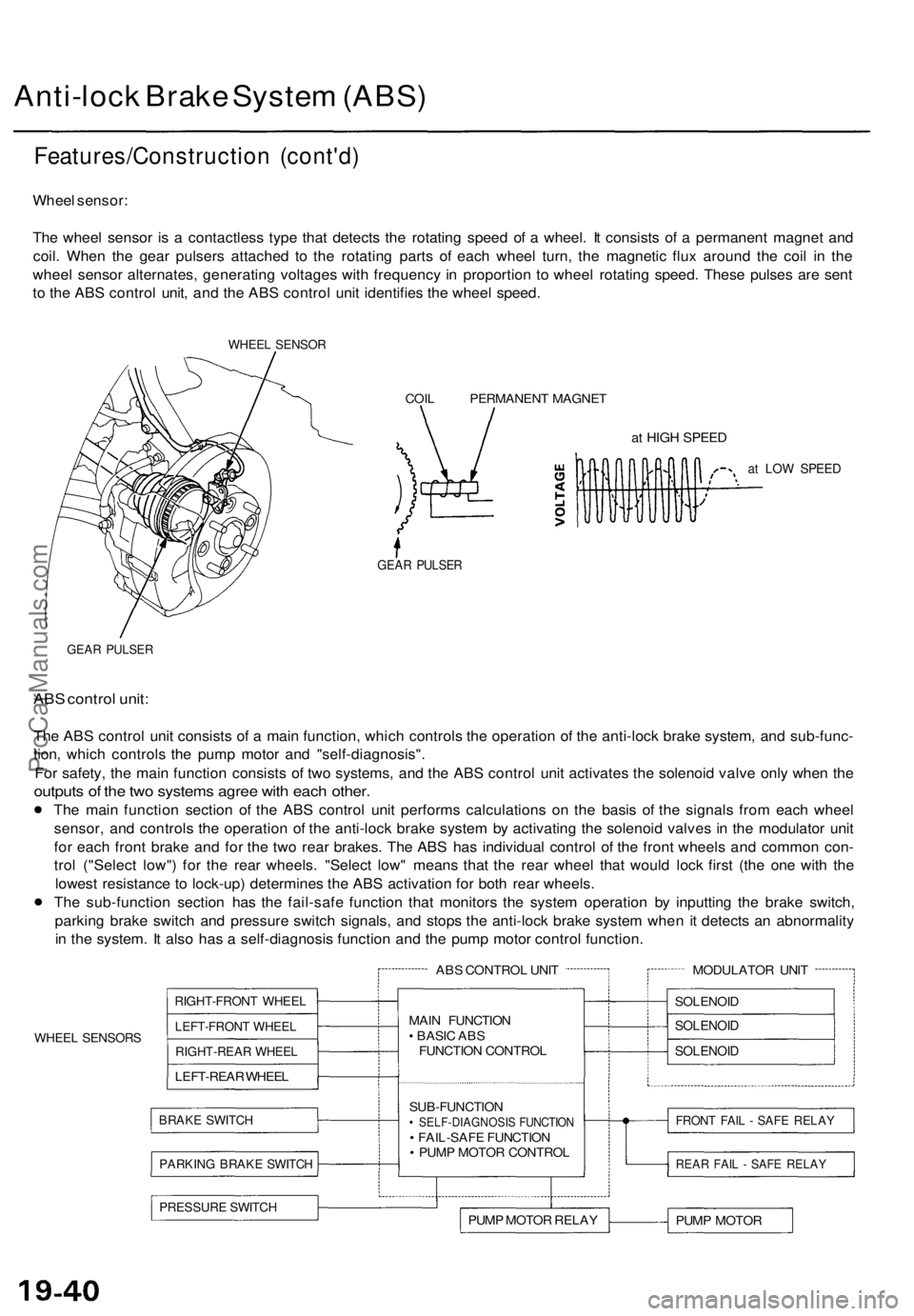
Anti-lock Brake System (ABS)
Features/Construction (cont'd)
Wheel sensor:
The wheel sensor is a contactless type that detects the rotating speed of a wheel. It consists of a permanent magnet and
coil. When the gear pulsers attached to the rotating parts of each wheel turn, the magnetic flux around the coil in the
wheel sensor alternates, generating voltages with frequency in proportion to wheel rotating speed. These pulses are sent
to the ABS control unit, and the ABS control unit identifies the wheel speed.
WHEEL SENSOR
COIL PERMANENT MAGNET
at HIGH SPEED
at LOW SPEED
GEAR PULSER
GEAR PULSER
ABS control unit:
The ABS control unit consists of a main function, which controls the operation of the anti-lock brake system, and sub-func-
tion, which controls the pump motor and "self-diagnosis".
For safety, the main function consists of two systems, and the ABS control unit activates the solenoid valve only when the
outputs of the two systems agree with each other.
The main function section of the ABS control unit performs calculations on the basis of the signals from each wheel
sensor, and controls the operation of the anti-lock brake system by activating the solenoid valves in the modulator unit
for each front brake and for the two rear brakes. The ABS has individual control of the front wheels and common con-
trol ("Select low") for the rear wheels. "Select low" means that the rear wheel that would lock first (the one with the
lowest resistance to lock-up) determines the ABS activation for both rear wheels.
The sub-function section has the fail-safe function that monitors the system operation by inputting the brake switch,
parking brake switch and pressure switch signals, and stops the anti-lock brake system when it detects an abnormality
in the system. It also has a self-diagnosis function and the pump motor control function.
WHEEL SENSORS
ABS CONTROL UNIT
RIGHT-FRONT WHEEL
LEFT-FRONT WHEEL
RIGHT-REAR WHEEL
LEFT-REAR WHEEL
BRAKE SWITCH
PARKING BRAKE SWITCH
MAIN FUNCTION
• BASIC ABS
FUNCTION CONTROL
SUB-FUNCTION
• SELF-DIAGNOSIS FUNCTION
• FAIL-SAFE FUNCTION
• PUMP MOTOR CONTROL
PRESSURE SWITCH
PUMP MOTOR RELAY
MODULATOR UNIT
SOLENOID
SOLENOID
SOLENOID
FRONT FAIL - SAFE RELAY
REAR FAIL - SAFE RELAY
PUMP MOTORProCarManuals.com
Page 1292 of 1771
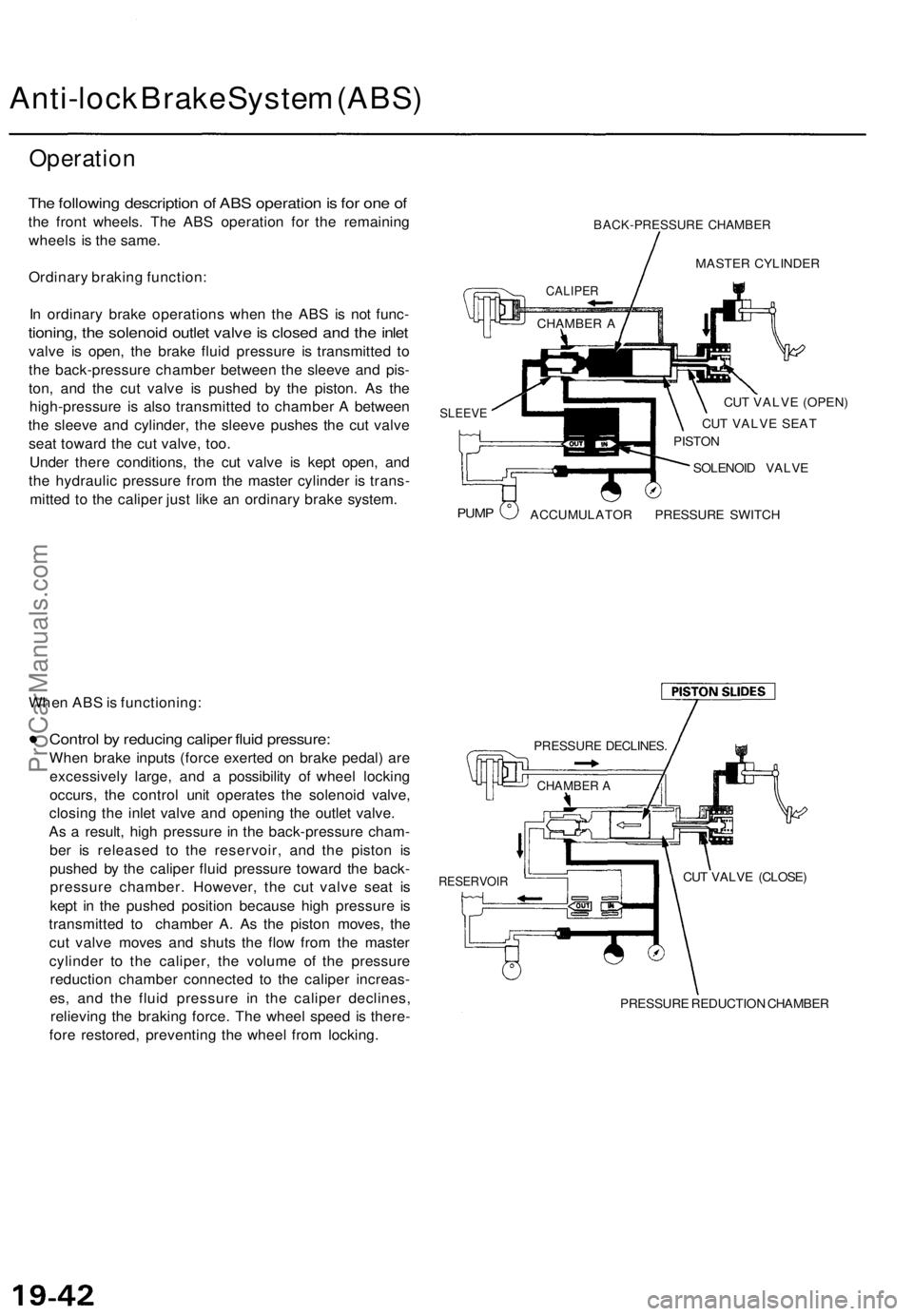
Anti-lock Brake System (ABS)
Operation
The following description of ABS operation is for one of
the front wheels. The ABS operation for the remaining
wheels is the same.
Ordinary braking function:
In ordinary brake operations when the ABS is not func-
tioning, the solenoid outlet valve is closed and the inlet
valve is open, the brake fluid pressure is transmitted to
the back-pressure chamber between the sleeve and pis-
ton, and the cut valve is pushed by the piston. As the
high-pressure is also transmitted to chamber A between
the sleeve and cylinder, the sleeve pushes the cut valve
seat toward the cut valve, too.
Under there conditions, the cut valve is kept open, and
the hydraulic pressure from the master cylinder is trans-
mitted to the caliper just like an ordinary brake system.
BACK-PRESSURE CHAMBER
MASTER CYLINDER
CUT VALVE (OPEN)
CUT VALVE SEAT
PISTON
SOLENOID VALVE
PUMP
ACCUMULATOR PRESSURE SWITCH
When ABS is functioning:
Control by reducing caliper fluid pressure:
When brake inputs (force exerted on brake pedal) are
excessively large, and a possibility of wheel locking
occurs, the control unit operates the solenoid valve,
closing the inlet valve and opening the outlet valve.
As a result, high pressure in the back-pressure cham-
ber is released to the reservoir, and the piston is
pushed by the caliper fluid pressure toward the back-
pressure chamber. However, the cut valve seat is
kept in the pushed position because high pressure is
transmitted to chamber A. As the piston moves, the
cut valve moves and shuts the flow from the master
cylinder to the caliper, the volume of the pressure
reduction chamber connected to the caliper increas-
es, and the fluid pressure in the caliper declines,
relieving the braking force. The wheel speed is there-
fore restored, preventing the wheel from locking.
RESERVOIR
PRESSURE REDUCTION CHAMBER
CALIPER
CHAMBER A
SLEEVE
PRESSURE DECLINES.
CHAMBER A
CUT VALVE (CLOSE)ProCarManuals.com
Page 1293 of 1771
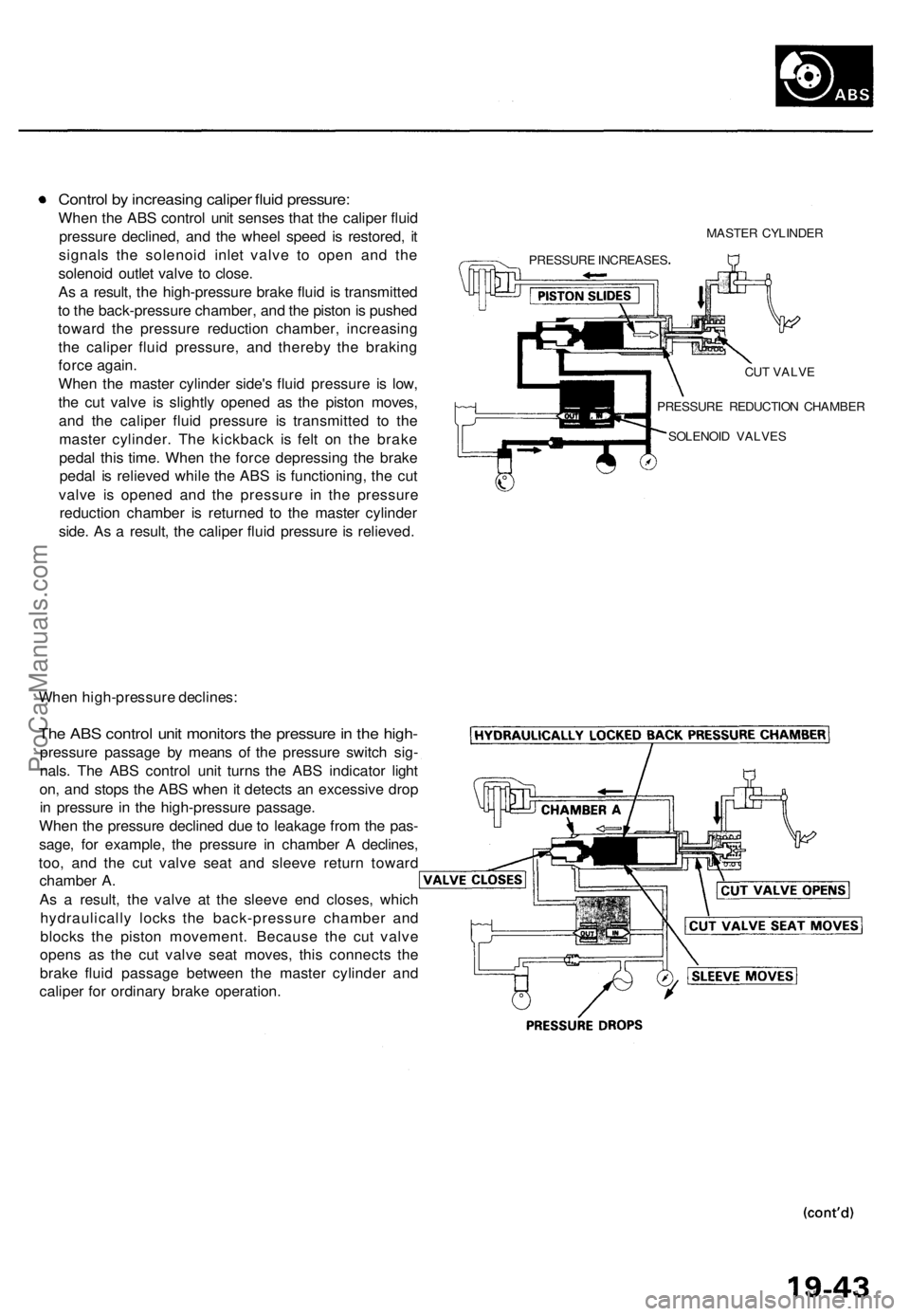
Control by increasing caliper fluid pressure:
When the ABS control unit senses that the caliper fluid
pressure declined, and the wheel speed is restored, it
signals the solenoid inlet valve to open and the
solenoid outlet valve to close.
As a result, the high-pressure brake fluid is transmitted
to the back-pressure chamber, and the piston is pushed
toward the pressure reduction chamber, increasing
the caliper fluid pressure, and thereby the braking
force again.
When the master cylinder side's fluid pressure is low,
the cut valve is slightly opened as the piston moves,
and the caliper fluid pressure is transmitted to the
master cylinder. The kickback is felt on the brake
pedal this time. When the force depressing the brake
pedal is relieved while the ABS is functioning, the cut
valve is opened and the pressure in the pressure
reduction chamber is returned to the master cylinder
side. As a result, the caliper fluid pressure is relieved.
MASTER CYLINDER
PRESSURE INCREASES
CUT VALVE
PRESSURE REDUCTION CHAMBER
SOLENOID VALVES
When high-pressure declines:
The ABS control unit monitors the pressure in the high-
pressure passage by means of the pressure switch sig-
nals. The ABS control unit turns the ABS indicator light
on, and stops the ABS when it detects an excessive drop
in pressure in the high-pressure passage.
When the pressure declined due to leakage from the pas-
sage, for example, the pressure in chamber A declines,
too, and the cut valve seat and sleeve return toward
chamber A.
As a result, the valve at the sleeve end closes, which
hydraulically locks the back-pressure chamber and
blocks the piston movement. Because the cut valve
opens as the cut valve seat moves, this connects the
brake fluid passage between the master cylinder and
caliper for ordinary brake operation.ProCarManuals.com